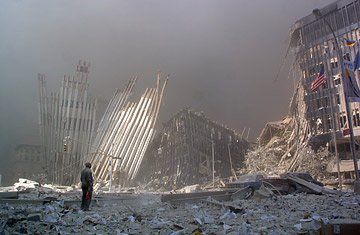
A man stands in the rubble, and calls out asking if anyone needs help, after the collapse of the first World Trade Center Tower in New York City on September 11, 2001.
(6 of 10)
But it can inspire us as well. In the face of overwhelming fear, most of these people grew calm. They reshuffled their priorities instantly. The terror did not leave them hysterical; it left them lonely, searching to connect with the people who knew them best. And it offered them a fleeting chance to ease the grief to come. Another passenger on Sweeney's plane, Peter Hanson, 32, flying with his wife and small daughter, called his parents just before impact. "I think we're going down, but don't worry. It's going to be quick." From United Flight 93, flight attendant CeeCee Lyles and passenger Lauren Grandcolas called their husbands before crashing outside Pittsburgh. "We have been hijacked," said Grandcolas. "They are being kind. I love you."
Of course, there were other calls that came prematurely, at the peak of panic. From the 92nd floor of the south tower, Steve Cafiero called his mother. He described seeing a plane jutting out of the neighboring tower and people falling to the ground. He sounded calm. But suddenly he started screaming. He dropped the phone. His mother Grace Kneski held the line for half an hour, hoping he'd come back. He never did. Now she assumes her son was screaming at the sight of a plane heading toward his window. Despite that horror, she insists she is glad they spoke. "I can hear his voice from now on, forever," she says. "It's embedded in my brain." --By Amanda Ripley
They Knew the Odds
Bravery is the first thing we think of in fire fighters. But New York City's fire chief of special operations, Ray Downey, is hailed by his peers as the smartest fire fighter on a force full of smart fire fighters. Few men can enter a burning building and see order. Downey can. Few men can walk through the wake of chaos, be it a hurricane's wrath or a terrorist's bomb, and know how to organize and proceed. Downey can.
We use the present tense not out of foolish optimism but out of respect. Fire fighters aren't dead until their bodies are found; for now, Downey is unaccounted for. On Tuesday, Downey, 63, a father of five, including two New York City fire fighters, did what 39 years of experience had taught him to do best. He arrived at an emergency and sprang into action. By several accounts, Downey moved toward the rubble of the first tower, hoping to save some of those trapped underneath. He had to have known the odds. A few months ago, he spoke about the funerals of three beloved fire fighters. "You say to yourself, 'Not me.' But when the unexpected happens, there's nothing you can do about it." When the second tower collapsed, Downey disappeared.
Downey is the most decorated fire fighter in the department, and that isn't even at the top of his resume. He headed the search and rescue efforts at the World Trade Center bombing in 1993, the Oklahoma City bombing in 1995 and the TWA Flight 800 explosion in 1996. He volunteered to coordinate a rescue effort after a hurricane hit the Dominican Republic and served on the Gilmore Commission, a congressional advisory panel that last year issued a report titled Toward a National Strategy for Combating Terrorism. The man knows disaster.
He also knows what he signed up for. Speaking at another fire fighter's funeral, this one less than two weeks ago, Downey said, "We have to accept this as part of the job. Sometimes in this job, goodbye really is goodbye." --By Josh Tyrangiel
